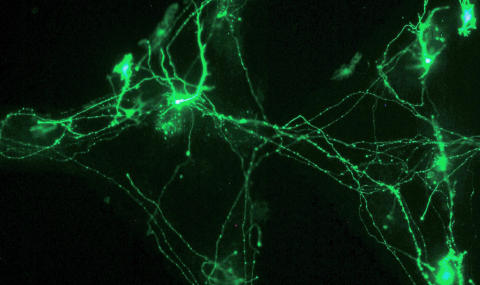Oscillatory activity is widespread in dynamic neuronal networks. The main paradigm for the origin of periodicity consists of specialized pacemaking elements that synchronize and drive the rest of the network; however, other models exist.
Here, we studied the spontaneous emergence of synchronized periodic bursting in a network of cultured dissociated neurons from rat hippocampus and cortex. Surprisingly, about 60% of all active neurons were self-sustained oscillators when disconnected, each with its own natural frequency.
The individual neuron’s tendency to oscillate and the corresponding oscillation frequency are controlled by its excitability. The single neuron intrinsic oscillations were blocked by riluzole, and are thus dependent on persistent sodium leak currents.
Upon a gradual retrieval of connectivity, the synchrony evolves: Loose synchrony appears already at weak connectivity, with the oscillators converging to one common oscillation frequency, yet shifted in phase across the population. Further strengthening of the connectivity causes a reduction in the mean phase shifts until zero-lag is achieved, manifested by synchronous periodic network bursts. Interestingly, the frequency of network bursting matches the average of the intrinsic frequencies.
Overall, the network behaves like other universal systems, where order emerges spontaneously by entrainment of independent rhythmic units. Although simplified with respect to circuitry in the brain, our results attribute a basic functional role for intrinsic single neuron excitability mechanisms in driving the network’s activity and dynamics, contributing to our understanding of developing neural circuits.
Disconnected network: 0 mM [Ca2+].
(Upper) Relative topography (on the MEA) of the active electrodes. When a neuron fires a spike, its corresponding location flashes in white.
(Lower) Equivalent total activity (sum of spikes over all electrodes) is shown in 20-ms bins. This same culture is shown in consecutive recordings at different calcium concentrations corresponding to different coupling strengths.
Weakly coupled network: 0.1 mM [Ca2+].
Medium coupled network: 0.2 mM [Ca2+].
Strongly coupled network: 0.5 mM [Ca2+].
Network synchronization in hippocampal neurons
Penn Y., Segal M. & Moses E. (2016) PNAS. 113, 12, p. 3341-3346
Article, Supplementary


